Chapter 1. Linear Equations in Linear Algebra
1.9 The Matrix of a Linear Transformation
The Matrix of a Linear Transformation
Theorem 10:
Let be a linear transformation. Then there exists a unique matrix such that
In fact, is the matrix whose th column is the vector , where is the th column of the identity matrix in
Proof:
Write , and
use the linearity of to compute
유일성에 대한 증명은 생략(연습문제)
- The matrix A in (3) is called the standard matrix for the linear transformation .
- We know now that every linear transformation from to can be viewed as a matrix transformation, and vice versa.
- The term linear transformation focuses on a property of a mapping,
- while matrix transformation describes how such a mapping is implemented.
Example 2:
Find the standard matrix for the dilation transformation , for .
Solution:
Write
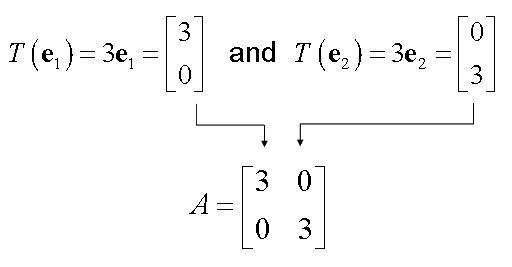
Existence and Uniqueness Questions
Tables 1-4 illustrate other common geometric linear transformations of the plane.
Table 1. Reflections
| Transformation | Image of the Unit Square | Standard Matrix |
|---|---|---|
| Reflecting through the -axis | 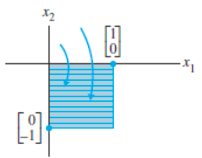 |
|
| Reflecting through the -axis |  |
|
| Reflecting through the line | 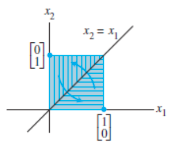 |
|
| Reflecting through the line | 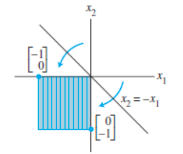 |
|
| Reflecting through the origin | 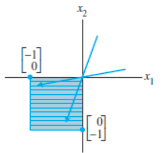 |
Table 2. Contractions and Expansions
| Transformation | Image of the Unit Square | Standard Matrix |
|---|---|---|
| Horizontal contraction and expansion |  |
|
| Vertical contraction and expansion |  |
Table 3. Shears
| Transformation | Image of the Unit Square | Standard Matrix |
|---|---|---|
| Horizontal shear | 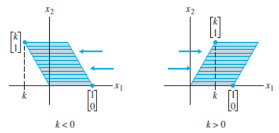 |
|
| Vertical shear | 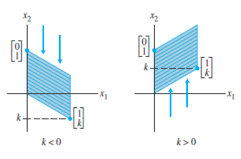 |
Table 4. Projections
| Transformation | Image of the Unit Square | Standard Matrix |
|---|---|---|
| Projection onto the -axis | 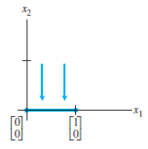 |
|
| Projection onto the -axis | 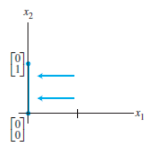 |
Definition : onto (전사)
A mapping is said to be onto(전사) if each in is the image of at least one in .
- Equivalently, is onto when the range of is all of the codomain .
- That is, maps onto if, for each in the codomain , there exists at least one solution of .
- Dose map onto is an existence question.
- The mapping is not onto when there is some in for which the equation has no solution.
- See the figure below.

Figure 3. Is the range of all of ?
Definition : one-to-one
Definition: A mapping is said to be one-to-one(일대일) if each in is the image of at most one in .
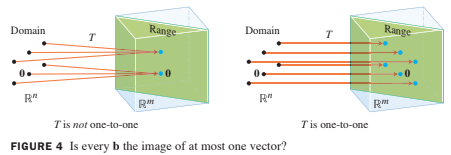
Example 4:
Let be the linear transformation whose standard matrix is
Does map onto
Is a one-to-one mapping?
Solution of Example 4:
Since happens to be in echelon form, we can see at once that has a pivot position in each row. By Theorem 4 in Section 1.4, for each in the equation is consistent. In other words, the linear transformation maps (its domain) onto .
However, since the equation has a free variable (because there are four variables and only three basic variables), each is the image of more than one . This is, is not one-to-one.
Theorem 11:
Let be a linear transformation.
Then is one-to-one if and only if the equation has only the trivial solution.
Proof of Theorem 11:
Since T is linear, . If is one-to-one, then the equation has at most one solution and hence only the trivial solution.
If is not one-to-one, then there is a that is the image of at least two different vectors in --say, and . That is and . But then, since is linear,
The vector is not zero, since . Hence the equation has more than one solution. So, either the two conditions in the theorem are both true or they are both false.
Theorem 12:
Let be a linear transformation and let be the standard matrix for . Then:
- maps onto if and only if the columns of span ;
- is one-to-one if and only if the columns of are linearly independent.
Proof of Theorem 12
1.
By Theorem 4 in Section 1.4, the columns of span if and only if for each in the equation is consistent—in other words, if and only if for every ,the equation has at least one solution. This is true if and only if maps onto .
2.
The equations and are the same except for notation. So, by Theorem 11, is one-to-one if and only if has only the trivial solution. This happens if and only if the columns of are linearly independent.